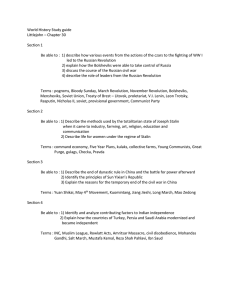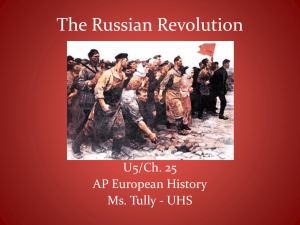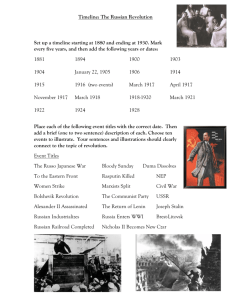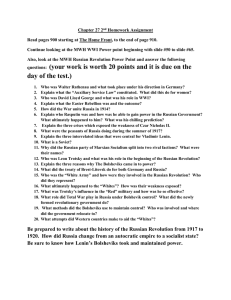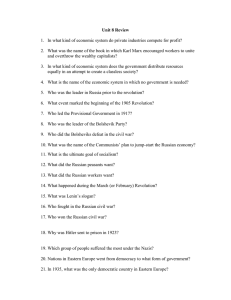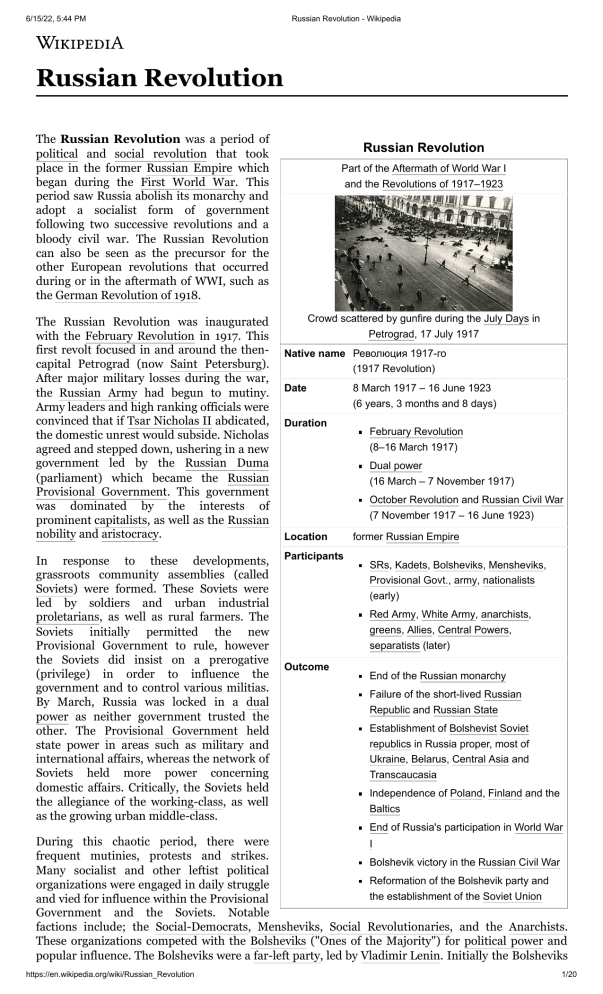
6/15/22, 5:44 PM Russian Revolution - Wikipedia Russian Revolution The Russian Revolution was a period of political and social revolution that took place in the former Russian Empire which began during the First World War. This period saw Russia abolish its monarchy and adopt a socialist form of government following two successive revolutions and a bloody civil war. The Russian Revolution can also be seen as the precursor for the other European revolutions that occurred during or in the aftermath of WWI, such as the German Revolution of 1918. The Russian Revolution was inaugurated with the February Revolution in 1917. This first revolt focused in and around the thencapital Petrograd (now Saint Petersburg). After major military losses during the war, the Russian Army had begun to mutiny. Army leaders and high ranking officials were convinced that if Tsar Nicholas II abdicated, the domestic unrest would subside. Nicholas agreed and stepped down, ushering in a new government led by the Russian Duma (parliament) which became the Russian Provisional Government. This government was dominated by the interests of prominent capitalists, as well as the Russian nobility and aristocracy. In response to these developments, grassroots community assemblies (called Soviets) were formed. These Soviets were led by soldiers and urban industrial proletarians, as well as rural farmers. The Soviets initially permitted the new Provisional Government to rule, however the Soviets did insist on a prerogative (privilege) in order to influence the government and to control various militias. By March, Russia was locked in a dual power as neither government trusted the other. The Provisional Government held state power in areas such as military and international affairs, whereas the network of Soviets held more power concerning domestic affairs. Critically, the Soviets held the allegiance of the working-class, as well as the growing urban middle-class. Russian Revolution Part of the Aftermath of World War I and the Revolutions of 1917–1923 Crowd scattered by gunfire during the July Days in Petrograd, 17 July 1917 Native name Революция 1917-го (1917 Revolution) Date Duration 8 March 1917 – 16 June 1923 (6 years, 3 months and 8 days) February Revolution (8–16 March 1917) Dual power (16 March – 7 November 1917) October Revolution and Russian Civil War (7 November 1917 – 16 June 1923) Location Participants former Russian Empire SRs, Kadets, Bolsheviks, Mensheviks, Provisional Govt., army, nationalists (early) Red Army, White Army, anarchists, greens, Allies, Central Powers, separatists (later) Outcome End of the Russian monarchy Failure of the short-lived Russian Republic and Russian State Establishment of Bolshevist Soviet republics in Russia proper, most of Ukraine, Belarus, Central Asia and Transcaucasia Independence of Poland, Finland and the Baltics End of Russia's participation in World War During this chaotic period, there were I frequent mutinies, protests and strikes. Bolshevik victory in the Russian Civil War Many socialist and other leftist political Reformation of the Bolshevik party and organizations were engaged in daily struggle the establishment of the Soviet Union and vied for influence within the Provisional Government and the Soviets. Notable factions include; the Social-Democrats, Mensheviks, Social Revolutionaries, and the Anarchists. These organizations competed with the Bolsheviks ("Ones of the Majority") for political power and popular influence. The Bolsheviks were a far-left party, led by Vladimir Lenin. Initially the Bolsheviks https://en.wikipedia.org/wiki/Russian_Revolution 1/20 6/15/22, 5:44 PM Russian Revolution - Wikipedia were marginalized faction, however that changed following a series of developments including the use of their slogan, peace, land, and bread which promised to cease war with Germany, give land to the peasantry, and end the famine caused by Russia's involvement in WWI. These slogans had a direct effect on the growing Bolshevik popularity.[1] Despite the virtual universal disdain towards the war effort, the Provisional Government chose to continue fighting anyway, giving the Bolsheviks and other socialist factions a justification to advance the revolution further. The Bolsheviks merged various workers' militias loyal to them into Red Guards, which would be capable of revolution.[2] The volatile situation in Russia reached its climax with the October Revolution, which was a Bolshevik armed insurrection by workers and soldiers in Petrograd that successfully overthrew the Provisional Government, transferring all its authority to the Bolsheviks. Under pressure from German military offensives, the Bolsheviks soon relocated the national capital to Moscow. The Bolsheviks had secured a strong base of support within the Soviets and, as the supreme governing party, established their own government, the Russian Soviet Federative Socialist Republic (RSFSR). The RSFSR began the process of reorganizing the former empire into the world's first socialist state, to practice soviet democracy on a national and international scale. Their promise to end Russia's participation in the First World War was fulfilled when the Bolshevik leaders signed the Treaty of Brest-Litovsk with Germany in March 1918. To further secure the new state, the Bolsheviks established the Cheka, a secret police that functioned as a revolutionary security service to weed out, execute, or punish those considered to be "enemies of the people" in campaigns called the red terror, consciously modeled on those of the French Revolution. Even though the Bolsheviks held large support in urban areas, the Bolsheviks had many enemies that refused to recognize their government. As a result, Russia erupted into a bloody civil war, which was fought between the "Reds" (Bolsheviks), and enemies of the Bolshevik regime collectively called the White Army. The White Army consisted of independence movements, monarchists, liberals, and other socialist factions opposed to the Bolsheviks. During the civil war, the Bolsheviks under the lead of Leon Trotsky began converting the Red Guard into the Red Army. The Red Army successfully defeated both the White Army and all rival socialist factions by 1923. While many notable historical events occurred in Moscow and Petrograd, there were also major changes in cities throughout the state, and among national minorities throughout the empire and in the rural areas, where peasants took over and redistributed land. As the war progressed, the RSFSR began establishing Soviet power in the newly independent republics that seceded from the Russian Empire. The RSFSR initially focused its efforts on the newly independent republics of: Armenia, Azerbaijan, Belarus, Georgia and Ukraine. Wartime cohesion and intervention from foreign powers prompted the RSFSR to begin unifying these nations under one flag and created the Union of Soviet Socialist Republics (USSR). Historians generally consider the end of the Russian Revolution to be in 1923 when the last anti-Bolshevik forces collapsed. The victorious Bolshevik Party reconstituted itself into the Communist Party of the Soviet Union and would remain in power for over six decades. Contents Background Economic and social changes Political issues World War I February Revolution Dvoyevlastiye October Revolution Russian Civil War Revolutionary tribunals Execution of the imperial family Symbolism The revolution and the world Historiography Cultural portrayal Film Video games https://en.wikipedia.org/wiki/Russian_Revolution 2/20

